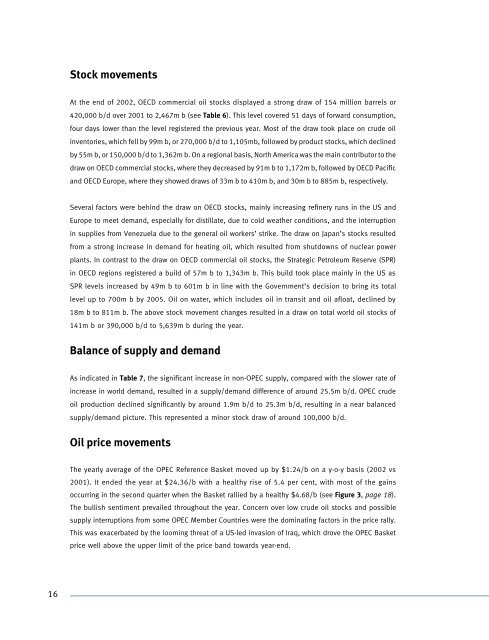2002 - OPEC
2002 - OPEC
2002 - OPEC
You also want an ePaper? Increase the reach of your titles
YUMPU automatically turns print PDFs into web optimized ePapers that Google loves.
16<br />
Stock movements<br />
At the end of <strong>2002</strong>, OECD commercial oil stocks displayed a strong draw of 154 million barrels or<br />
420,000 b/d over 2001 to 2,467m b (see Table 6). This level covered 51 days of forward consumption,<br />
four days lower than the level registered the previous year. Most of the draw took place on crude oil<br />
inventories, which fell by 99m b, or 270,000 b/d to 1,105mb, followed by product stocks, which declined<br />
by 55m b, or 150,000 b/d to 1,362m b. On a regional basis, North America was the main contributor to the<br />
draw on OECD commercial stocks, where they decreased by 91m b to 1,172m b, followed by OECD Pacific<br />
and OECD Europe, where they showed draws of 33m b to 410m b, and 30m b to 885m b, respectively.<br />
Several factors were behind the draw on OECD stocks, mainly increasing refinery runs in the US and<br />
Europe to meet demand, especially for distillate, due to cold weather conditions, and the interruption<br />
in supplies from Venezuela due to the general oil workers’ strike. The draw on Japan’s stocks resulted<br />
from a strong increase in demand for heating oil, which resulted from shutdowns of nuclear power<br />
plants. In contrast to the draw on OECD commercial oil stocks, the Strategic Petroleum Reserve (SPR)<br />
in OECD regions registered a build of 57m b to 1,343m b. This build took place mainly in the US as<br />
SPR levels increased by 49m b to 601m b in line with the Government’s decision to bring its total<br />
level up to 700m b by 2005. Oil on water, which includes oil in transit and oil afloat, declined by<br />
18m b to 811m b. The above stock movement changes resulted in a draw on total world oil stocks of<br />
141m b or 390,000 b/d to 5,639m b during the year.<br />
Balance of supply and demand<br />
As indicated in Table 7, the significant increase in non-<strong>OPEC</strong> supply, compared with the slower rate of<br />
increase in world demand, resulted in a supply/demand difference of around 25.5m b/d. <strong>OPEC</strong> crude<br />
oil production declined significantly by around 1.9m b/d to 25.3m b/d, resulting in a near balanced<br />
supply/demand picture. This represented a minor stock draw of around 100,000 b/d.<br />
Oil price movements<br />
The yearly average of the <strong>OPEC</strong> Reference Basket moved up by $1.24/b on a y-o-y basis (<strong>2002</strong> vs<br />
2001). It ended the year at $24.36/b with a healthy rise of 5.4 per cent, with most of the gains<br />
occurring in the second quarter when the Basket rallied by a healthy $4.68/b (see Figure 3, page 18).<br />
The bullish sentiment prevailed throughout the year. Concern over low crude oil stocks and possible<br />
supply interruptions from some <strong>OPEC</strong> Member Countries were the dominating factors in the price rally.<br />
This was exacerbated by the looming threat of a US-led invasion of Iraq, which drove the <strong>OPEC</strong> Basket<br />
price well above the upper limit of the price band towards year-end.
















